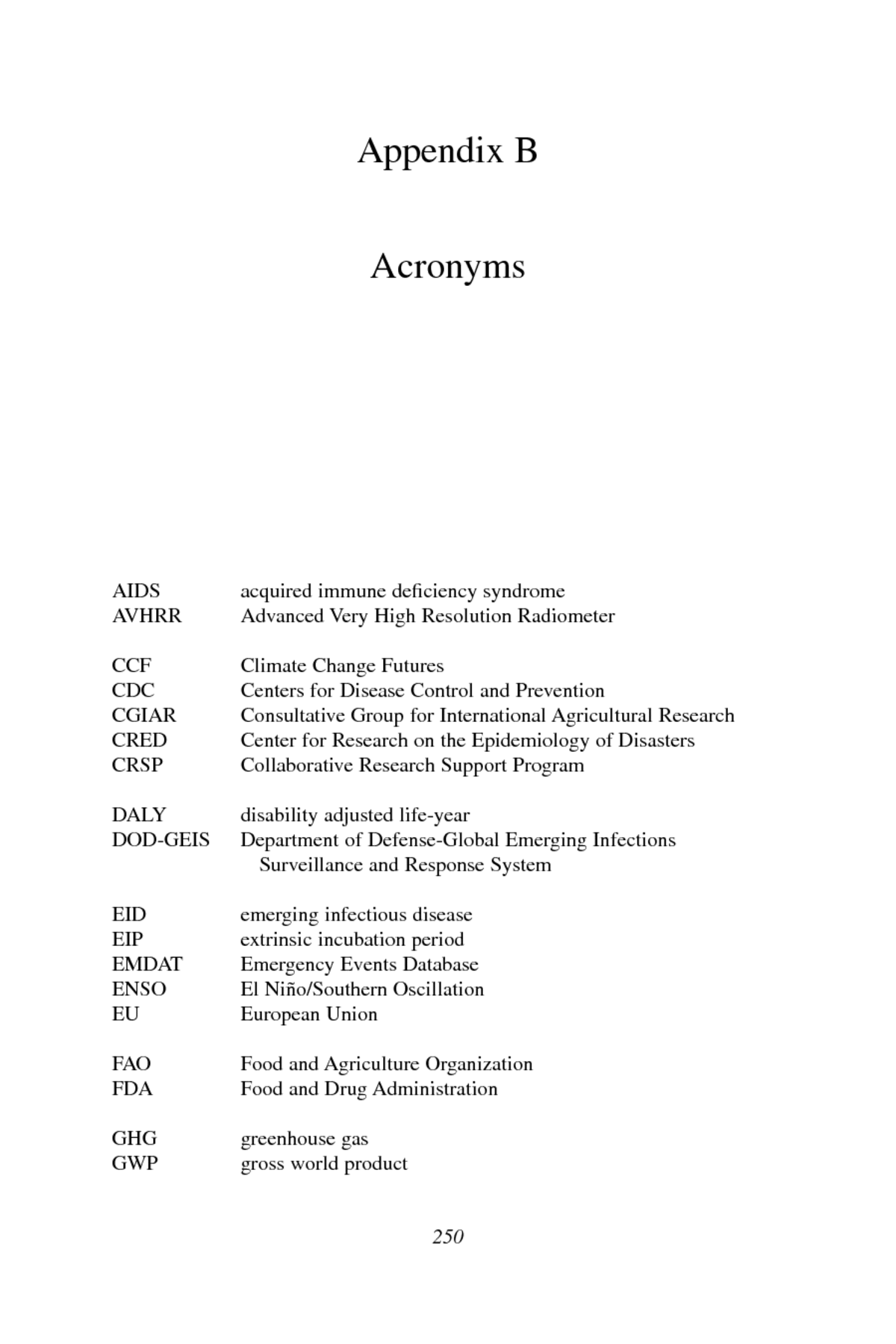Below is the uncorrected machine-read text of this chapter, intended to provide our own search engines and external engines with highly rich, chapter-representative searchable text of each book. Because it is UNCORRECTED material, please consider the following text as a useful but insufficient proxy for the authoritative book pages.
Appendix B Acronyms AIDS acquired immune deficiency syndrome AVHRR Advanced Very High Resolution Radiometer CCF Climate Change Futures CDC Centers for Disease Control and Prevention CGIAR Consultative Group for International Agricultural Research CRED Center for Research on the Epidemiology of Disasters CRSP Collaborative Research Support Program DALY disability adjusted life-year DOD-GEIS Department of Defense-Global Emerging Infections Surveillance and Response System EID emerging infectious disease EIP extrinsic incubation period EMDAT Emergency Events Database ENSO El Niño/Southern Oscillation EU European Union FAO Food and Agriculture Organization FDA Food and Drug Administration GHG greenhouse gas GWP gross world product 250
APPENDIX B 251 HAB harmful algal bloom HHS U.S. Department of Health and Human Services HIMAL highland malaria project HIV human immunodeficiency virus HPV human papilloma virus HTLV human T-cell lymphotropic virus IOM Institute of Medicine IPCC Intergovernmental Panel on Climate Change IPM Integrated Pest Management KEMRI Kenya Medical Research Institute LSQ large square MODIS Moderate Resolution Imaging Spectroradiometer NAS National Academy of Sciences NASA National Aeronautics and Space Administration NASA-GSFC NASA Goddard Space Flight Center NDVI Normalized Difference Vegetation Index NIA National Intelligence Assessment NIC National Intelligence Council NIE National Intelligence Estimate NIH National Institutes of Health NOAA National Oceanic and Atmospheric Administration NPP net primary productivity NRC National Research Council NSF National Science Foundation OFDA Office of U.S. Foreign Disaster Assistance OIRED Office of International Research, Education, and Development OLR outgoing longwave radiation PDO Pacific Decadal Oscillation PSQ primary square RSV respiratory syncytial virus RT-PCR reverse transcriptase-polymerase chain reaction RVF Rift Valley fever SANREM Sustainable Agriculture and Natural Resource Management SARS severe acute respiratory syndrome
252 GLOBAL CLIMATE CHANGE AND EXTREME WEATHER EVENTS SRES Special Report on Emissions Scenarios SST sea surface temperature TBE tick-borne encephalitis TOPS Terrestrial Observation and Prediction System ULV ultra low volume UN United Nations UNDP United Nations Development Programme UNHCR United Nations High Commissioner for Refugees USAID U.S. Agency for International Development USAMRU U.S. Army Medical Research Unit VHS viral hemorrhagic septicemia WHO World Health Organization WNV West Nile virus



